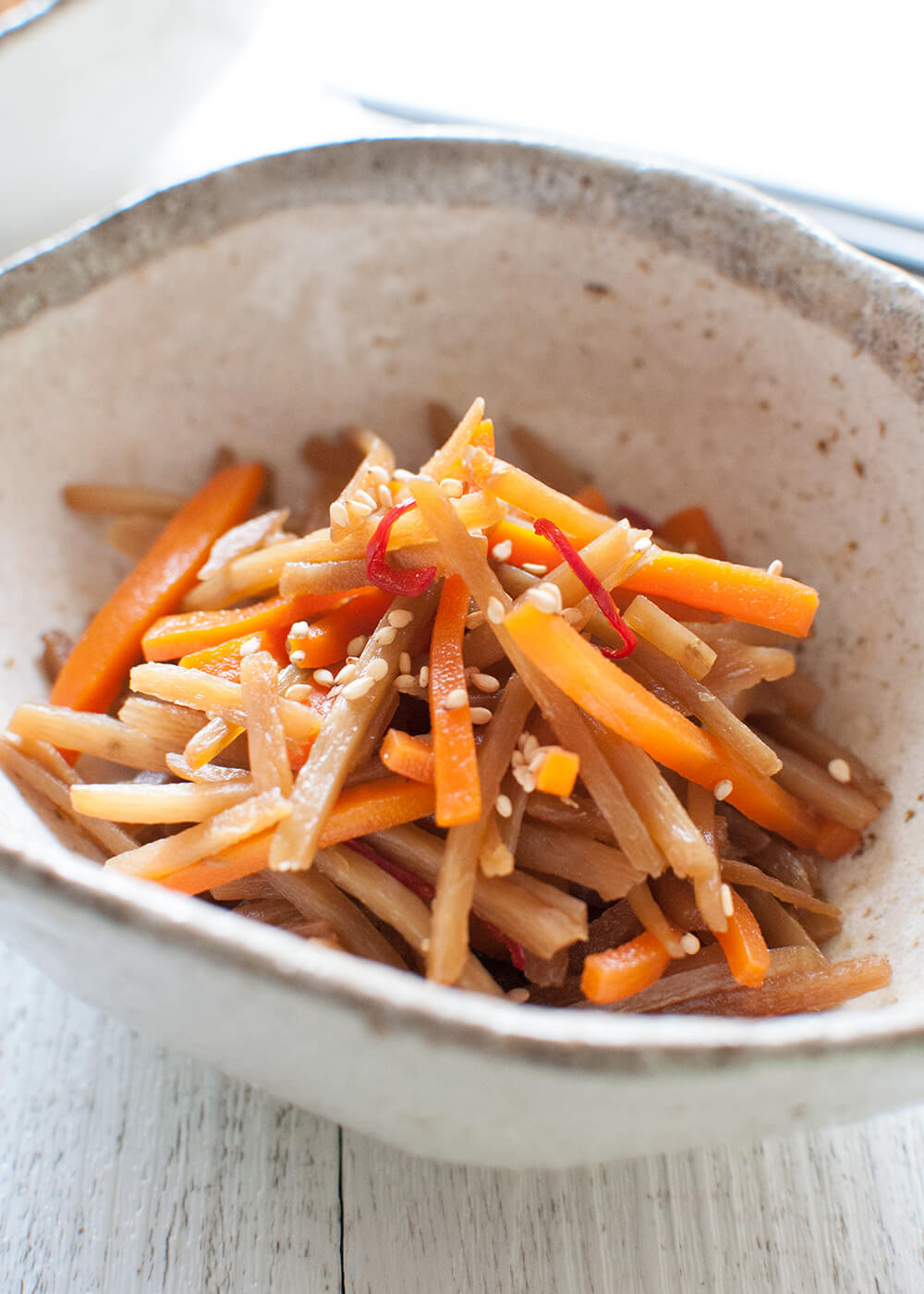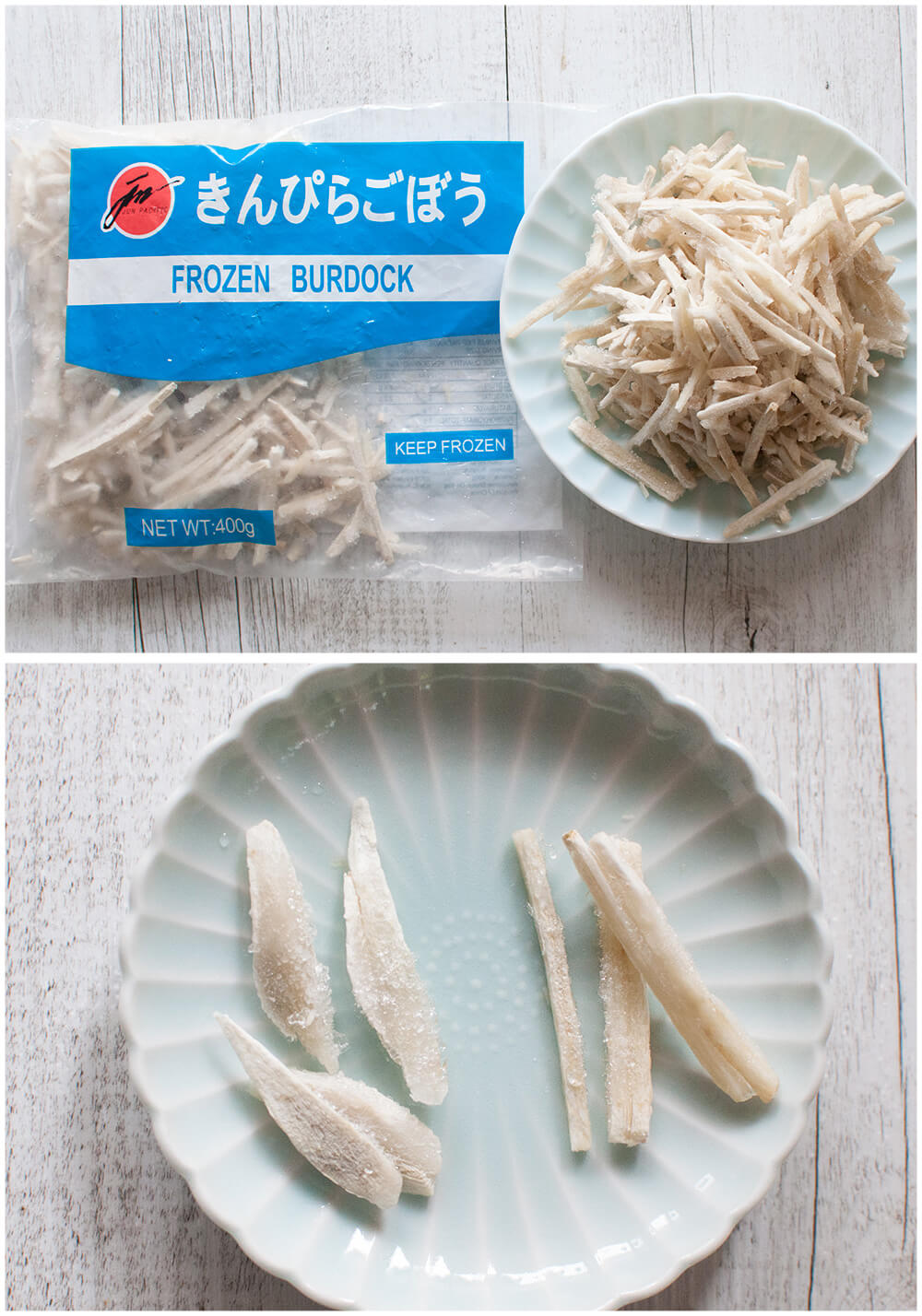A typical Japanese home cooking dish, Braised Burdock (Kinpira Gobō) is a vegetable side dish. Burdock root and carrot are cut into matchsticks and cooked in a slightly sweet soy sauce. It is very fast to make and can be made ahead of time. For this reason, it is often served in a bento box.

I need to call it Kinpira Gobō instead of Braised Burdock throughout this blog because it just doesn’t sound right for me and if I use the English name, it does not sound like one of the dishes that Japanese people call ‘taste of my mother’s home cooking’.
‘Braised Burdock’ is not a direct translation of ‘Kinpira Gobō’ (金平ごぼう), but rather an interpretation of how it is made because the word ‘kinpira gobō’ does not represent what it is at all except that burdock is involved.
The word ‘gobō’ (ごぼう) means burdock. This bit is easy. But ‘kinpira’ (金平) is actually the name of the main male character in the traditional Japanese narrative music performance called ‘Jōruri’ (浄瑠璃). His name is Kinpira Sakata (坂田金平) and in this old story, he was a very strong and brave man.
Since burdock has a very crunchy texture and invigorates you, and spicy chilli is added to the flavouring of kinpira gobō, they linked the characteristics of this dish to Kinpira Sakata. It’s a funny way of naming the dish and you won’t imagine a masculine man from the dish but that’s where the name came from.
About Burdock
If you have ever tried burdock, you know that it is a bit stringy, but it has a very unique flavour. It is a root vegetable, usually similar in length to daikon or even longer but very thin. They are often sold unwashed, with soil on them so you only see the colour of the almost black soil, but the flesh of gobō is close to white.
The reason for selling burdock with soil on is that you are meant to eat even the skin of the burdock root and also you can keep the burdock fresh much longer with soil on.
If you have a very fresh burdock root, you don’t need to peel the skin before cooking. Simply wash the root using a brush or a scrubber. If it is not so fresh and the surface of the root is a bit hard, try to scrape off the skin using the spine of the cooking knife instead of using a peeler. This is because the surface area of the root has the most nutrition.
When you cut burdock, drop the pieces into cold water as soon as possible because it becomes brownish when exposed to air. But do not leave them in water more than 10 minutes as they lose the burdock flavour. You will notice that the cold water becomes brown as you accumulate chopped burdock in it. Quickly rinse them and drain the water in a strainer.

Until a couple of years ago, I could not buy fresh burdock even at Japanese grocery stores. But now they often sell fresh burdock. I was so excited about it and I once bought a fresh root and used it in Chikuzenni (Simmered Chicken and Vegetables).
But unless I need to use large pieces of burdock, I use frozen burdock that is already either shredded or julienned into matchsticks. You can buy frozen burdock at Japanese grocery stores and some Asian stores. The top photo below is a bag of frozen matchstick burdock. The bottom photo compares shredded burdock (left) and matchstick burdock (right).

They are quite handy because you don’t need to cut them at all. You can use either type of frozen burdock to make kinpira gobō but I used matchsticks today.
Other than kinpira gobō, I use shredded burdock in miso soup, tempura, mixed rice, and fish cakes, etc. Matchstick burdock can also be used in tempura, salad, and stir fry. See some of my recipes, Tonjiru (Pork and Vegetable Miso Soup) , Kakiage (Mixed Vegetable Tempura), and Japanese Fried Fish Cakes (Satsuma Age). I will need to post some more burdock dishes!
Kinpira
When I was a child, my grandmother used to cook kinpira gobō. Her kinpira gobō was made with only burdock. But I add a small amount of carrot cut into the same size matchsticks. I think that these days, the majority of Kinpira Gobō has carrot in it, perhaps because it can add more appetising colour to the dish.
The basic flavouring is a mixture of soy sauce and sugar with a little chilli added. The vegetables are stir fried first, then cooked in the flavoured sauce. Actually, this method of cooking and flavouring is called ‘kinpira’ and you can make kinpira even with thinly sliced lotus root, just carrot, daikon skin, or konnyaku.
If you made kinpira with sliced lotus root, it is called ‘kinpira renkon’ (金平れんこん) where ‘renkon’ means lotus root. Similarly, if carrot, it will become ‘kinpira ninjin’ (金平人参), and ‘kinpira daikon’ (金平大根), ‘kinpira konnyaku’ (金平コンニャク) and so on.

My kinpira has sake and mirin in addition to the basic flavouring and I cook the vegetables in water for a couple of minutes before adding flavour to it. Although burdock is a bit of a stringy vegetable, it does not take very long to cook. You can cook this Kinpira Gobō in just over 10 minutes.
Kinpira gobō keeps for 4-5 days in the fridge. You can also freeze it but I never freeze my Kinpira Gobō because I use frozen burdock and freezing food twice is not a good idea. Also, it gets eaten very fast anyway. This is a great side dish to keep in the fridge when you think you might need a little something to add to the meal.
Yumiko![]()

A typical Japanese home cooking dish, Braised Burdock (Kinpira Gobō) is a vegetable side dish. Burdock root and carrot are cut into matchsticks and cooked in a slightly sweet soy sauce. It is very fast to make and can be made ahead of time.
- Roasted white sesame seeds
-
Add oil to a saucepan and heat over medium high heat. Add burdock and sauté for a couple of minutes.
-
Add carrots and mix well and cook for 30 seconds.
-
Add water, bring down the heat to low and place a lid on. Cook for 2 minutes. (note 4)
-
Remove the lid, add the remaining ingredients, turn the heat up to medium high and cook until the sauce almost evaporates.
-
Turn the heat off and let it cool. Serve individually or in one bowl with sesame seeds sprinkled on top.
1. You can buy bags of frozen burdock that are already cut into match sticks or shredded. You can buy them at Japanese grocery stores and some Asian stores.
If you are using a fresh burdock, please refer to my post under the heading 'ABOUT BURDOCK' where I explained how to prepare it. Cut the root into 5cm (2") long pieces, slice each log 3mm (⅛") thick vertically, then cut the slices same direction into 3 mm (⅛") matchsticks.
2. If you are using shredded burdock, I would suggest that you cut the carrot to a size similar to the burdock pieces.
3. Chilli can be fresh or dried.
If you have diners who cannot handle chilli, you can omit this. And when serving, you can serve it with shichimi tōgarashi (Japanese chilli spice mixture) for those who want a bit of kick.
4. If water evaporates too fast, add some more water.
5. This is a perfect side dish for a bento box. It keeps 4-5 days in the fridge. If you are using fresh burdock, then you can freeze Kinpira Gobo.
I let burdock seed go crazy this past fall & poof! What a stand of burdock! I’ve known about using it for tea and I have a smoothie recipe that calls for it but I was interested in other recipes. Wow! I had no idea it is a popular Japanese vegetable. Tried this recipe (although didn’t have the vinegar or wine). I used coconut oil, coconut aminos for soy sauce, and 1 T white wine vinegar for the wine & vinegar), sugar, red pepper flakes. I didn’t quite get matchstick sizes but the dish is pleasing. I am curious how much better it would be with the correct ingredients. I am excited to try your other burdock recipes (maybe my picky family will even eat it).
Hi Audrey, I envy you that you have so many burdock roots! Instead of cutting into matchsticks, you might find the sasagaki cut (shaving cut) is easier. I have some recipes using burdock (including burdock chips!). I hope you try them all.
Hi Yumiko,
Your recipes for burdock sound great. We are in Japan at the moment, and eat kinpira gobo whenever we find it.
Do you know where to buy fresh burdock in Australia?
And how about frozen?
I have never found either in Australia, and want to start cooking more with burdock after we get back.
Thanks a lot.
Ming
Hi Ming, firstly, enjoy your time in Japan!
I buy them at Japanese grocery stores such as Tokyo Mart in Northbridge, Umeya in Crows Nest. It is seasonal and you may not always find it.
you can also buy frozen burdock in a bag that is already julienned/shredded specifically for Kinpira Gobō. You can often find them at Asian grocery stores a well as Japanese grocery stores.
Thank you so much. Will definitely try that when we get home .
Your recipes are fantastic!
Ming
Thank you!
Thank you for the wonderful explanation and recipe. I have always loved making and eating kinpira ever since I became interested in macrobiotic cooking but I never knew all that fascinating and helpful information that you added — especially where the word comes from. Looking forward to trying your recipe!
Thanks for a feedback, Julie. To make reading more interesting, I try to add one little story or facts about the dish or ingredient when I can. I am glad to know that it’s working.
If using frozen burdock root, should it be thawed before cooking?
Hi Diane, yes, it should be thawed as you need to sauté first. When thawed, squeeze the water out.
hello yumiko, I was wondering if the frozen burdock has been peeled. it seems very white on the outside. I’ve never looked for it frozen because in southern ca. it is always available fresh. I mainly started buying it primarily for it’s health benefits and if you think the frozen has been peeled i’ll stick with the fresh. I love your blog and always take pictures of new products so I can look for them at the store. thank you for any feedback.
Hi Kim, I have no way of knowing if the skin is peeled in the process of making frozen cut burdock. However, given that it is a common knowledge not to peel the skin when it comes to burdock, I doubt the skin is peeled.
If you can get fresh burdock any time (lucky you!), you should use fresh burdock. Burdock can be frozen if you cannot use up the entire root. Cut the root into either matchsticks or shave them (don’t forget to leave them in water to prevent them from getting brownish), pat dry them and put in a zip lock bag, flattened, vacuum sealed, then freeze. Keeps about 1 month without losing flavour.
thank you for the info